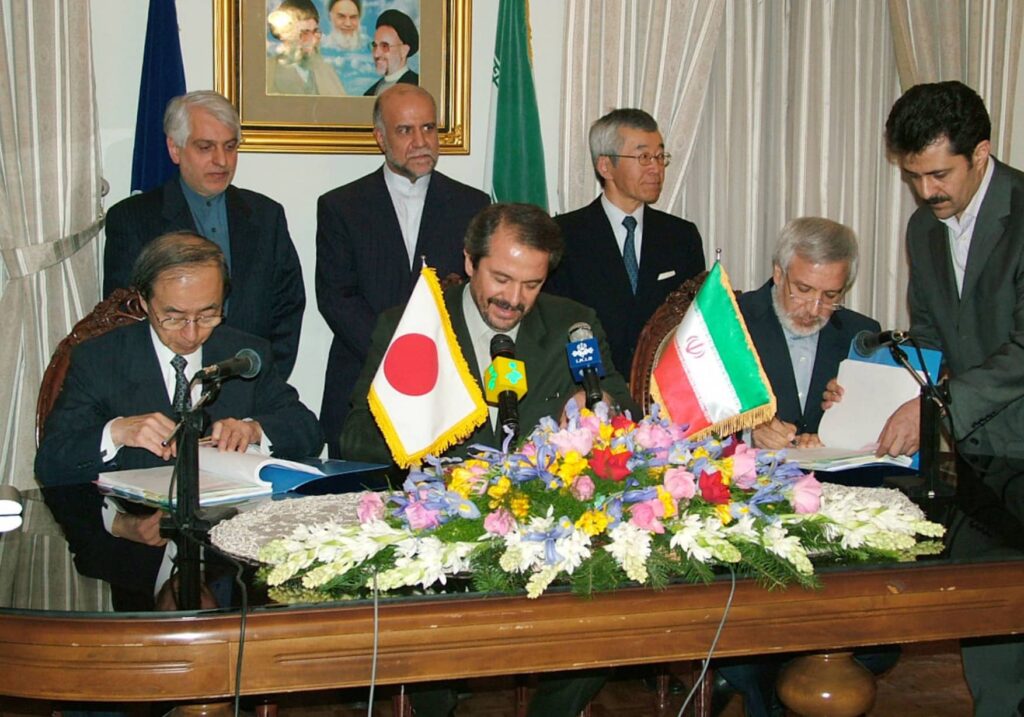For Japan, a good relationship with Iran was for decades essential for its economic prosperity. Japan had a policy of “agreeing to disagree” with the US over Iran. Today, that policy has started to change.
A Relationship Based on Japan’s Quest for Energy Security
Overviews of Japan and Iran note that trade and cultural ties have existed for over one thousand years. This is mostly accurate. For example, a beautiful glass goblet in the Japanese Imperial Treasury was brought to Japan (via China) during the Sasanian Empire. However, the modern relationship between Japan and Iran is based on realpolitik on both sides.
Japan’s quest for energy security, particularly in securing oil imports, has been a critical focus since the mid-20th century. President Roosevelt’s ban on American oil exports to Imperial Japan in July 1941, when America supplied 90 percent of Japan’s oil imports, prompted the Japanese Imperial Government to declare war against the US and its allies in December of that year.
Securing oil imports to sustain Japan’s post-World War II economic growth remained a paramount national concern and led Japan to naturally gravitate towards Persian Gulf oil exporters. Despite Japan’s continuous efforts to diversify its oil sources over time, the Persian Gulf region still has a 90 percent share of Japanese oil imports even now. Among Persian Gulf oil-exporting countries, Iran was the largest oil exporter to Japan in the 1970s.
This oil-based relationship with Iran started with the “Nitsushou Maru” episode. In 1951, Iranian Prime Minister Mosaddeq nationalized the British-owned Anglo-Iranian oil company. As a countermeasure, the UK government banned Iranian oil exports and applied a naval blockade along the coast of Iran. In 1953, Idemitsu Kosan, an aggressive Japanese oil company, sent an oil tanker, the “Nitsushou Maru,” to Iran, which dodged the British blockade and returned to Japan full of Iranian oil.
Iranians highly appreciated this venture, and thus began the close bilateral relations. Iran’s share of Japan’s oil imports reached almost 50 percent in the 1970s. Even after the 1979 Islamic revolution, Iran’s share of Japan’s oil imports remained around 10 percent, until 2011. One key factor in Japan’s continuing dependence on Iran is the fact that each oil refinery is tailored to a type of crude oil; and many Japanese oil refineries were optimized for Iranian light crude oil.
Before the 1979 Islamic revolution, Japan was not only a major buyer of Iranian oil but also a significant investor in Iran. In 1974, a Japanese consortium invested over a billion US dollars and started to build the Iran Japan Petrochemical Company, Iran’s first major petrochemical industrial complex. The Japanese consortium was obliged to withdraw from the project in 1984 after the outbreak of the Iran-Iraq war.
The 1979 Islamic Revolution and US embassy hostage crisis severely damaged Iran’s relationship with all of US allies – with the exception of Japan. It continued to import as much Iranian oil as possible. Furthermore, the Japanese government engaged in shuttle diplomacy to mediate between Iran and Iraq during their war in the 1980s, because of the risks to Japanese oil imports from the Persian Gulf. It was a rare case of a Japanese diplomatic initiative (along with the peace process in Cambodia and reconciliation in Myanmar). Because the US and other G7 countries somewhat favored Iraq during the Iran-Iraq war, out of fear of Iran’s radical Islamist ideology, an Iran suffering from international isolation likely appreciated these Japanese efforts.
Era of US-Japan “Agreeing to Disagree” Over Iran
Even after the Iran-Iraq war ended in 1988, Japan continued to support Iran not only by importing Iranian oil but also by supporting Iranian national projects, which often caused friction with the US, resulting in a mutual policy of “agreeing to disagree.”
This was unusual for post-World War II relations between Japan and the US. Japan has depended on the US security umbrella for its national security and, in general, compromised whenever the US had serious demands on it. For example, Japan accepted voluntary export controls of textiles, automobiles, and semiconductors to the US; Japan opened its domestic market to US agricultural and technology products and insurance services.
Iran, however, was an exception in US-Japan relations owing to Japan’s desperate dependence on imported oil. The Japanese side believed its relations with Iran wouldn’t damage relations with the US since they didn’t directly affect US business interests..
There were two notable cases of “agreeing to disagree” during this period.
In 1990, the Iranian government requested a significant loan from Japan to build the Masjid-e-Soleiman hydropower station project. Immediately, the US government opposed the loan because it would free up Iranian funds to support terrorism. After the negotiations with the US, the Japanese government did agree to reduce the loan from 1.2 billion US dollars to 300 million, but still extended the loan to Iran.
In 2000, the Japanese government agreed to develop Iran’s Azadegan oil field. However, in 2002, the US requested that the project be suspended owing to the revelation of Iran’s secret nuclear program. Despite US pressure, a Japanese consortium started developing the Azadegan field in 2004. With growing US pressure and international concern about Iran’s nuclear program, the Japanese consortium finally gave up the project in 2010; it was subsequently taken over by the Chinese state-owned oil company CNPC.
Although the US government constantly discouraged Japan from having closer relations with Iran, sometimes it also asked Japan to use its influence on Iran. For example, on July 28, 1985, President Regan called Prime Minister Nakasone and asked that Japan engage Iran, believed to be behind the kidnapping of dozens of Americans in Lebanon. PM Nakasone sent a special emissary to Tehran, Damascus, and Beirut, but the mission was unsuccessful, partially because the Iran-Contra affair was ongoing and the Iranians suspected this genuine Japanese effort of being false.

Zenith of Japan-Iran Relations
The period between Prime Minister Abe’s visit to Tehran in June 2019 and Iranian President Rouhani’s return visit to Tokyo in December 2019 was the zenith of Japan-Iran realpolitik relations. Abe’s visit to Iran in June 2019 was not a courtesy call. It was initiated at the request of President Trump, who had resumed unilateral economic sanctions to pressure Iran to renegotiate the Joint Comprehensive Plan of Action. Trump asked PM Abe to persuade Iran to talk with the US (as described in John Bolton’s book The Room Where It Happened, pages 385-386).
In Tehran, PM Abe proposed some Japanese political and economic initiatives as incentives to convince Iranians to negotiate with President Trump, and the Iranians showed interest. They also knew that PM Abe had established an excellent relationship with President Trump and thus could perhaps exercise some influence on him.
Tough negotiations ensued between Japanese and Iranian diplomats, up to and including during President Rouhani’s visit to Japan in December. Iranians always seek “a final discount” in such negotiations, as they do in the bazaar. President Rouhani had a very long meeting with Abe in Tokyo, causing the cancellation of an official banquet at the Japanese Prime Minister’s residence on the evening of December 20, 2019. But no agreement or consensus was reached and Abe’s initiative failed. Perhaps because US economic sanctions had only resumed six months earlier, Iranians hadn’t yet faced severe financial difficulty. If negotiated one year later, the Abe initiative might have resulted in the Iranian attitude being more flexible.
Abe’s failed full-scale diplomatic initiative in 2019 ended Japan’s realpolitik approach toward Iran. Japan has since kept its distance from the Islamic Republic of Iran owing to a focus on Japan-US relations.
Growing Japanese Security Concerns
Why? Over the past decade, geopolitical tensions in the Asia-Pacific initiated by North Korea and China are growing. North Korea continues to develop ballistic missiles and nuclear weapons that threaten Japan. China is rapidly expanding its military power and behaving with a more assertive attitude towards its neighbors, including Japan.
In particular, China claims sovereignty over the Senkaku Islands, which are tiny, deserted islands close to Taiwan that have a significant strategic value for China as access to the Pacific Ocean. China is using “salami-slicing tactics” to send first hundreds of fishing boats, followed by coast guard ships on the pretext of protecting Chinese fishing boats, to drive off Japanese fishing boats. Through these measures, China intends to undermine Japan’s effective control of the Senkaku Islands.
Ironically, when US power was overwhelming in the Indo-Pacific region, Japanese national security, protected by the US, was taken for granted by the Japanese. The Japanese didn’t hesitate to “agree to disagree” with the US on Iran. But now, with growing threats from North Korea and China, while US military power appears to be overstretched particularly in Europe and in the Middle East, Japan’s security environment has changed.
Today Japan needs to be more confident about the US commitment to its security, leaving no room to “agree to disagree” with the US over Iran. The Iranian people may have recognized a gradual but fundamental change in the Japanese attitude toward them. Iran can no longer count on Japan as a friend in need.

